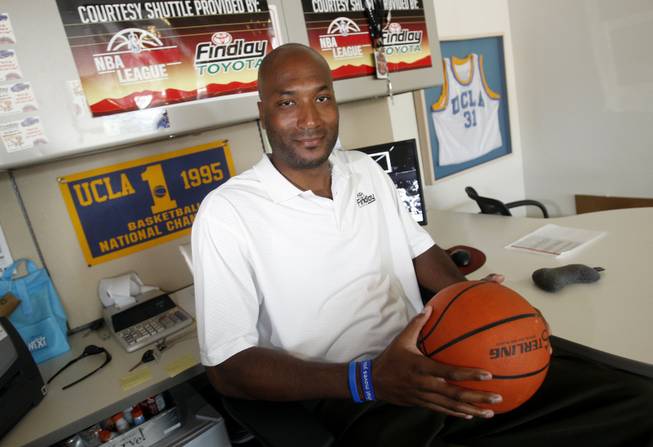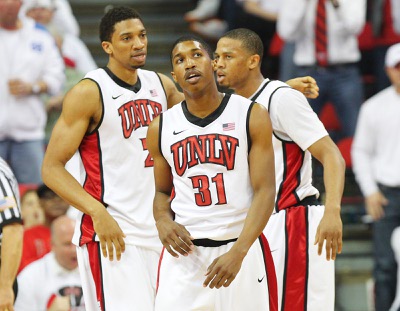
Isaac Brekken / AP
In this photo taken Saturday, Sept. 18, 2010, former UCLA basketball player Ed O’Bannon is pictured at his office at Findlay Toyota.
Sunday, June 8, 2014 | 2 a.m.
In the virtual world, No. 31 played only one season at UNLV. As a freshman guard in the EA Sports video game “NCAA Basketball 10,” No. 31 probably didn’t see much court time, and only in dynasty mode did he develop.
In the real world, Justin Hawkins wore No. 31 throughout his four-year career for the Rebels. He’s a real person — the one No. 31 was based on — who happened to enroll in school just as athletes started to really take a stand against the NCAA, particularly for not receiving compensation for use of their likeness.
“I knew a revolution was going to come sooner or later because a lot of us would talk about it,” Hawkins said.
A 2013 graduate, Hawkins now works at Findlay Toyota in Henderson alongside former UCLA basketball player Ed O’Bannon, the face of a possibly paradigm-shifting lawsuit that’s set to go to trial June 9. The plaintiffs, who include former NCAA and NBA stars Bill Russell and Oscar Robertson, filed a class-action lawsuit seeking an injunction against the NCAA for violating federal antitrust laws. In the suit, filed in 2009, they contend that the NCAA acted illegally by not allowing athletes to profit from their likenesses, particularly in TV broadcasts.
The argument for paying college athletes
The college athletics system was created in simpler times. Back then, conferences truly were regional because traveling was much more difficult. Competitions weren’t too different from extracurricular activities.
Fast forward to 2014. College athletics are a multibillion-dollar industry, and the system is completely outdated.
The term “student-athlete” frequently is used as a crutch by people who make money off of college athletics’ popularity. They say scholarships have incredible value, and that’s true. But they’re not nearly enough.
Not when college football and basketball coaches are the highest-paid public employees in 39 of 50 states, according to Deadspin. Not when athletic directors’ contracts include elements as tone deaf as an $18,000 bonus for Ohio State Athletic Director Gene Smith for one of the Buckeyes’ wrestlers winning a national title.
The people most responsible for generating the NCAA’s revenue — $913 million in 2013, according to Sports Illustrated — carry the most risk while getting the least compensation.
“These players are killing themselves, and at Texas last year, we made $163 million,” former Texas football coach Mack Brown said in 2013.
The mistake from the start was tying athletics to academic institutions. Given that reality, it is not an easy fix. It is a necessary one, though.
Why the NCAA shouldn't go that far
In April, the NCAA made a couple changes that show it’s listening.
First, it approved unlimited snacks and meals for all competing scholarship and walk-on athletes. Previously, scholarships covered only three meals a day – sometimes not enough for the diet an athlete must maintain. Walk-ons often had been on their own.
Then the Division I Board of Directors approved a restructuring that would create a council group to oversee and react to day-to-day policy and legislative decisions. A few student-athletes would be selected to sit on the council alongside athletic directors, giving players a voice in the process.
Changing things too dramatically, like paying athletes the way some suggest, could create a different environment that could make big-time athletics so devoid of the academic integrity the NCAA attempts to uphold that it would be better off run by a different group.
Then there’s the debate about what role athletes really have in revenue generation. When UNLV’s Mike Moser transferred to Oregon, for example, Ducks fans who didn’t have an opinion previously welcomed him in and cheered.
It’s the institution, then, more than the athletes that people are paying to see and support. Throw in the platform the NCAA offers for players to be seen and build recognition before a possible pro career, and the NCAA could argue it already does plenty to help its athletes.
EA Sports stopped making its college basketball series in 2010, two days after a federal judge awarded a favorable motion to the O’Bannon plaintiffs and those in a similar lawsuit brought by former Nebraska and Arizona State quarterback Sam Keller.
Although EA Sports said its decision had nothing to do with the lawsuits, but it subsequently stopped producing its more profitable college football series.
Two weeks ago, EA Sports and the Collegiate Licensing Company, which represents about 200 universities and had made school logos available for the video games, finalized a $40 million settlement removing them from the O’Bannon case and at least three other suits. Under the settlement, current and former players could receive up to $951 for every year they were featured in a video game.
As the game maker bailed out of the dispute, the NCAA braced for a battle.
At stake is hundreds of millions of dollars of annual revenue, much of which comes from TV contracts. An injunction could force the NCAA to share TV money with players.
In 2012-13 alone, the NCAA generated $681 million in revenue from its TV deal.
It’s not clear what percentage the players would get and whether every sport would receive the same amount — but those details would be determined by the courts and institutions should the plaintiffs win.
For years, college athletes just thought it was cool to see fans wearing jerseys with their numbers, even if the players didn’t get a dime. But for an athlete who enrolled months after the O’Bannon case was filed, the locker room conversations were different.
“What are we really doing it for?” Hawkins asked. “Is it for the love of the game or a bigger purpose?”
The NCAA argues players are fairly compensated with scholarships and the earning potential they stand to receive. The plaintiffs argue it’s time for the NCAA to stop shouting amateurism while those in power make money hand over fist.
Judge Claudia Wilken will decide.
Related cases
Keller v. NCAA, EA Sports
What’s it about? Sam Keller, a former quarterback at Nebraska and Arizona State, sued the NCAA and Electronic Arts, the maker of EA Sports games, on behalf of former, current and future Division I football and basketball players to receive compensation for the likenesses of athletes used in video games. The case is similar to O’Bannon’s but focuses on video games instead of TV.
What’s the latest? Last summer, an appeals court in California ruled that the First Amendment did not protect EA. A couple of months later, the video game company announced it would stop making its popular college football series and had reached a $40 million settlement to compensate former players. The settlement, finalized May 30, will provide payments to as many as 100,000 current and former athletes who appeared in EA Sports basketball and football games dating back to 2003. Keller’s case against the NCAA moves on with a trial possible in early 2015.
CAPA v. Northwestern
What’s it about? Former Northwestern quarterback Kain Colter helped form the College Athletes Players Association, and gained support from former Wildcat players, to try to form a labor union. The group wants to be designated university employees and treated as such.
The association’s desires are familiar — financial compensation and health coverage after graduation, for example — but instead of standing outside and asking for change, CAPA wants a seat at the table.
What’s the latest? In March, the Chicago office of the National Labor Relations Board ruled that the players have a right to unionize. Northwestern has appealed, the first step in a process that could take the case to the Supreme Court.
If the NLRB rules in favor of the players again, which is expected, it would affect only private institutions. But the decision could set a precedent for unionization at all schools and could affect antitrust cases against the NCAA.
Jenkins v. NCAA
What’s it about? Clemson defensive back Martin Jenkins and a trio of former players filed suit against the NCAA and the five power conferences in March to seek an injunction against NCAA rules limiting the amount of financial aid a player can receive. The plaintiffs essentially want to turn college football and men’s basketball into an open market.
The suit, which includes the Big Ten, Big 12, Pac-12, ACC and SEC, alleges that “price-fixing” by capping scholarship amounts limits competition.
What’s the latest? This case is in the very early stages and is unique partly because it includes a current athlete.
It’s clear that some type of systemic change is coming from the NCAA, either as a direct result of a court case or because of the weight of them all. There have been rumblings for a few years about the power conferences breaking off to form their own league, possibly independent of the NCAA, and public opinion has shifted against the NCAA on issues such as paying athletes to play.
By the time this case gets going, the current financial structure already may be changed. If that happens and players start to receive more financial compensation, watch out, fans: ticket prices and TV rights fees are likely to increase.


Join the Discussion:
Check this out for a full explanation of our conversion to the LiveFyre commenting system and instructions on how to sign up for an account.
Full comments policy